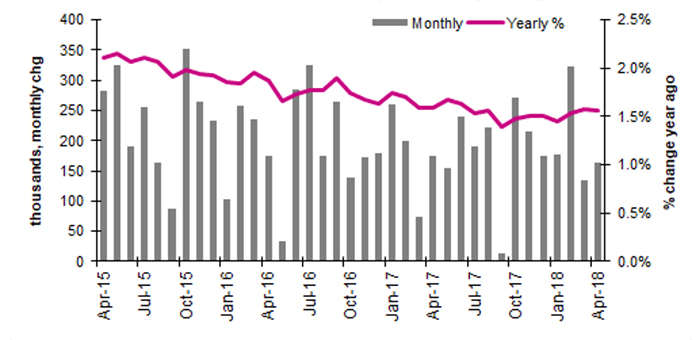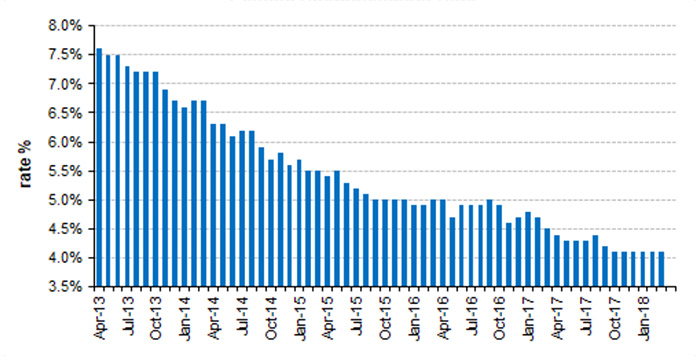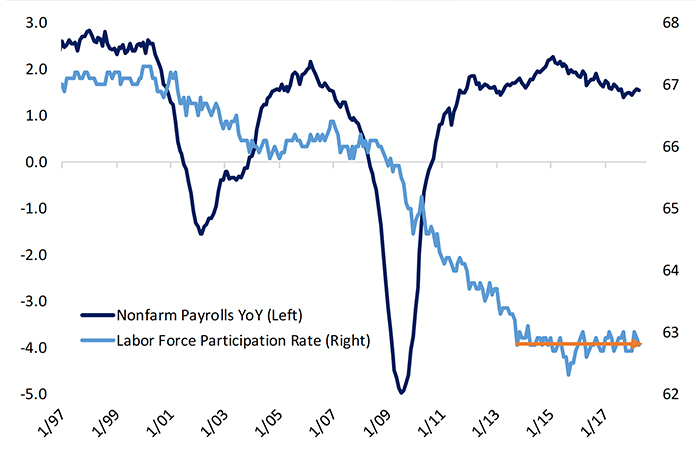
The employment report issued on Friday, May 4, had plenty of good news for the economy and investors:
- The headline unemployment rate fell to 3.9%, down from 4.1% one month earlier, reaching a 17-year low.
- The U.S. economy extended its record for the longest consecutive monthly stretch of positive jobs growth, now at 91 months.
- Average monthly jobs growth for 2018 is at 200,000, up from 182,000 on average for 2017.
- A key measure of “underemployment,” which includes discouraged job seekers and those who are part-time employed, fell to 7.8% in April 2018, according to The Wall Street Journal—the lowest level since 2001.
FIGURE 1: NONFARM PAYROLLS—MONTHLY AND YEARLY CHANGE

Sources: Barron’s, Econoday, Haver Analytics
FIGURE 2: CIVILIAN UNEMPLOYMENT RATE

Sources: Barron’s, Econoday, Haver Analytics
One of the employment data points Wall Street cheered the most was the relatively benign number for wage growth. Wages have increased in the broad economy by 2.6% over the past year and 0.1% last month, which The Wall Street Journal calls, “modest historically.” The market, according to analysts, liked the fact that the wage trend was not fueling a faster pace of inflation—which might help influence the Federal Reserve in keeping to its stated path of moderate interest rate hikes.
John Williams, now president of the Fed’s regional San Francisco bank, and soon to move to head the Fed’s New York bank, gave a positive outlook on the jobs report to CNBC. “I feel this is pretty much a Goldilocks economy,” Williams said, noting the strong labor market and moderate gains in wages and inflation. “I see this as all pretty positive.”
According to some market observers, three factors related to the employment situation give reason for some caution:
- The relatively slow pace of wage growth so far into the economic recovery is not a positive, especially as surging energy costs start to cut into household budgets and may impact other consumer spending.
- Periods of extremely low unemployment have, to some degree, been associated historically with “market tops.” Bespoke Investment Group noted last Friday, “For the equity market, low unemployment readings are a bad sign for forward returns on average.”
- The overall labor force participation rate remains at low levels compared to historical norms. While some attribute this to the increasing rate of retirement of baby boomers, it is not a healthy sign overall. Investor’s Business Daily points out, “The labor force participation rate in December 2000 was 67%. Today it is just 62.8%. … If labor force participation were the same today … the unemployment rate wouldn’t be 3.9%. It would be 10%!”
FIGURE 3: LABOR FORCE PARTICIPATION RATE VS. JOBS GROWTH RATE

Source: Bespoke Investment Group
